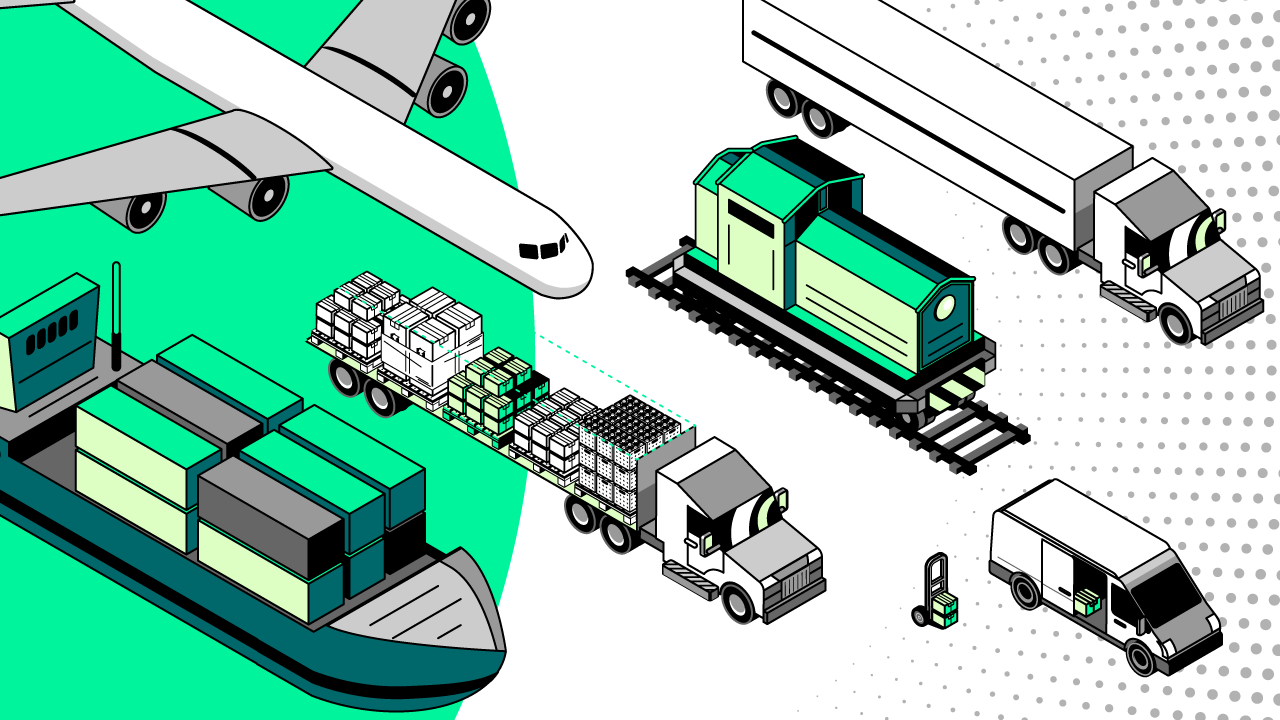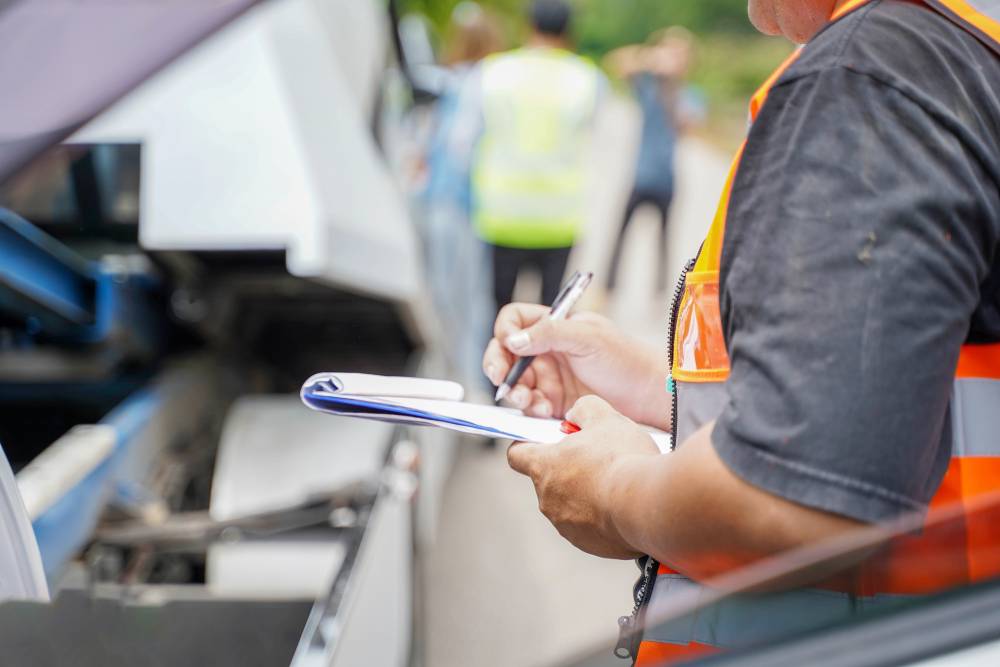If you’re in charge of logistics at your business, you know that it’s not just what you’re shipping — it’s how you’re shipping it.
There are a few different modes of transportation, and selecting the right one is essential to keep your supply chain as efficient, affordable and green as can be.
But with trucks, trains, planes and more to choose from, how do you know which mode is right for each shipment?
We’ve got you covered with a breakdown of the most common modes of transportation in logistics, the pros and cons of each, and when to use them.
What Is a Mode of Transportation?
Simply put, a “mode” is a type of transportation.
You can probably think of plenty of modes of transportation outside logistics — bicycles, skateboards, and the family sedan all fit this description.
But for our purposes here, we’re talking about the different companies, vehicles and systems that businesses use to transport goods.
If you can load it with pallets, large equipment or small packages, it’s an option for your freight shipping needs.
The Most Common Modes of Transportation in Logistics
- Full Truckload
- Standard LTL
- Volume LTL
- Shared Truckload
- Intermodal
- Box Trucks & Sprinter Vans
- Small Pack/Parcel
- Other Modes
Full Truckload

What Is Full Truckload Shipping?
Full truckload, sometimes abbreviated as FTL, TL or OTR (over the road), is when one shipper hires one entire semi-truck (typically a 53’ tractor trailer) to move freight from one facility to another.
In terms of freight moved in the U.S., full truckload dwarfs every other mode.
According to the Bureau of Transportation Statistics, trucks haul 11.5 billon tons of freight annually — that’s over 3 times as much as the next closest mode, pipelines, and nearly 10 times as much as rail.
Truckload Market Characteristics
- It’s massive, with over 900,000 carriers and $800 billion in annual revenue.
- It’s fragmented — 97% of carriers have 20 trucks or less.
- Pricing and capacity can be volatile due to extreme fragmentation.
When Should I Use Full Truckload?
If you are shipping 12 or more pallets of freight at the same time, all going to the same destination, you will likely need a full truck.
Below this number, you can consider less than truckload (LTL) options.
Within full truckload, there are many equipment types and service options (e.g., dry van, refrigerated, flatbed, hazmat, etc.) so no matter what you’re shipping, you can find an option for your freight.
With the exception of air freight, full truckload is the fastest and most direct way to move your freight. If you have a more flexible transit schedule for longer haul freight (500+ miles), intermodal is a cost-effective truckload conversion option.
Standard LTL
What Is LTL Shipping?
Less than truckload (LTL) shipping is when a single truck moves freight from multiple shippers at once — you are only booking a certain amount of space in the truck.
LTL carriers have specialized operations and complex, dense networks. When you ship via LTL, your freight will typically move through a series of drivers and terminals in that carrier’s network before it reaches its final destination.
Though most use a hub-and-spoke model, with local drivers and consolidation terminals, there are actually 7 distinct types of LTL carriers with different strategies and service footprints.
LTL Market Characteristics
- It’s relatively consolidated — there are around 200 LTL carriers in the U.S.
- It’s not growing — there have been no new entries to the market since the 1980s.
- Mergers and acquisitions have become more frequent among LTL carriers in recent years.
When Should I Use Standard LTL?
Standard LTL is for shipments of between 1 and 6 pallets. If you need to ship between 6 and 12 pallets, you will want to consider volume LTL or shared truckload. Above that, you’ll need a full truck.
LTL is often the go-to shipping mode for small and growing businesses, as they may not have enough freight to fill a full truck.
If you’re shipping LTL, be aware that any individual service needs (accessorials like lift gates, indoor delivery, etc.) factor into your rate, so disclose them early during the quoting process.
While similar to full truckload shipping in several ways, there are a few important differences that every shipper should be aware of before using LTL.
Volume LTL
What Is Volume LTL?
Volume LTL is similar to standard LTL, but used for larger LTL shipments between 6 and 12 pallets.
It makes use of excess trailer capacity in an LTL carrier’s network, which often occurs when there are equipment or freight density imbalances.
Volume LTL Market Characteristics
- Volume LTL occurs within the wider LTL freight market — the 200 or so carriers we mentioned above.
- Not all LTL carriers will offer volume capacity at any given time, but rather on a case-by-case basis determined by availability within their fleet.
- Because of this fluctuating availability, pricing is more volatile than standard LTL pricing.
When Should I Use Volume LTL?
Volume LTL is a great cost-saving option for shipments that are just a bit too big for standard LTL but not large enough to warrant a full truck.
Since volume LTL leverages excess capacity in a carrier’s network, the actual transit times can be less predictable — if your timing needs are specific, it might make sense to choose shared truckload or full truckload instead.
Shared Truckload
What Is Shared Truckload?
Shared truckload, also referred to as partial truckload or co-loading, uses full truckload carrier networks to combine multiple shippers’ freight on the same trailer.
Unlike LTL shipping (which also has multiple shippers’ freight on a single trailer), freight is delivered straight through from origin to destination by the same driver. In LTL, freight is unloaded and reloaded through a network of terminals and drivers.
Though it can be difficult to coordinate, when it works, shared truckload can provide huge cost and sustainability benefits.
Shared Truckload Market Characteristics
- In theory, any of the 900,000 for-hire trucking companies in the truckload market could participate in shared truckload shipping, though only a small subset of carriers regularly participate.
- The biggest limiting factor to wider adoption is coordination between multiple shippers.
- Advancements in digital freight matching technology are making it easier to create shared truckload opportunities.
When Should I Use Shared Truckload?
If you have an LTL shipment of 1 to 12 pallets (though larger LTL shipments of 6-12 pallets typically work best), shared truckload could be a good opportunity.
You can enjoy the benefits of truckload shipping (direct transit, less freight handling) at rates more comparable with LTL shipping. For truckload shippers, shared truckload can also help contribute to your company’s sustainability KPIs.
If you’re interested in shipping shared truckload, consider working with a third-party logistics provider (3PL).
They will likely have a broad carrier network to work with and can have the ability to digitally match your freight needs with that of other shippers.
Intermodal

What Is Intermodal Shipping?
Intermodal shipping is the transportation of containerized freight through a combination of rail and truckload.
At the origin and destination points, a drayage carrier (specialized trucking company) will haul your freight to and from a rail facility. Most of the mileage will make use of the extensive rail network throughout North America.
Per the BTS, 1.7 billion tons of freight move by rail in the U.S. annually.
Intermodal Market Characteristics
- There are two main railroads in the western half of the U.S. (the Union Pacific and BNSF) and two in the eastern half (the Norfolk Southern and the CSX).
- There are also 97,000 rail-owned containers in the U.S. that shippers can use for their freight (in addition to 198,000 privately owned containers).
- There are around 5,000 drayage carriers in the U.S.
When Should I Use Intermodal?
Intermodal is a full truckload conversion mode of transportation.
If you are moving truckload freight more than 600 miles, want to reduce your shipping rates, and reduce carbon emissions, intermodal is a great option.
While 600 miles is the low end, you’ll have to check with an intermodal provider to find out if there is service in your particular lane. Intermodal can reduce emissions by as much as 30% compared to shipping the same freight over the road.
There are some important differences between truckload and intermodal — namely around transit times and blocking and bracing. Make sure you work with an experienced provider to help set you up for success.
Box Trucks & Sprinter Vans

What Are Box Trucks & Sprinter Vans?
These are smaller vehicles — they can be anywhere from 10-26 feet in length — that are used to transport cargo, often for last mile delivery.
They’re commonly used to move appliances and other larger items.
Box Truck & Sprinter Van Market Characteristics
- There are low barriers to entry in this market because driving a box truck or sprinter van doesn’t require a commercial driver’s license (CDL) and because the vehicles are much cheaper than Class 8 trucks.
- While there are many private box truck/sprinter van drivers in the U.S., there are also consolidator companies who operate as single carriers in this space.
When Should I Use Box Trucks or Sprinter Vans?
Box trucks and sprinter vans can provide you direct, point-to-point delivery for your LTL freight, at rates that are much lower than a full truckload.
They also produce lower emissions than the Class 8 trucks you’d be booking if you shipped a full truckload.
Many carriers who specialize in this mode are regional, so it’s better suited for shorter distances, especially final-mile deliveries.
Small Pack/Parcel

What Is Parcel Shipping?
Shipments of small packages to unique recipients are classified as small pack/parcel. While it can be used in a business context, this is the kind of service you use to ship packages as an individual rather than freight as a business.
Parcel Market Characteristics
- There are three main companies that handle parcel shipping in the U.S. — UPS, FedEx and the United States Postal Service (USPS). They account for 78% of all parcels shipped in the country.
- Amazon does a further 21% of U.S. parcel shipping, but the bulk of this is delivery of their own sales volume.
- That means only 1% of parcels moved in the U.S. are shipped through a company outside of this group.
When Should I Use Parcel?
The most common business use of this mode is direct-to-customer sales. You can also use it to move specific parts or items between your own facilities whenever you have less than a pallet of freight.
The companies operating in this space typically offer itemized tracking for your packages to each of your recipients, making it well-suited for deliveries to customers.
Other Logistics Modes of Transportation

Your options as a shipper aren’t limited to those in the list above.
However, we’ve chosen to focus on those modes because they’re typically the go-to options for U.S. domestic freight outside of some very specialized cases.
The other major logistics modes of transportation are:
- Air
Used to move goods quickly and directly. Most common for international and intercontinental freight, and often used for lightweight, high-value items like electronics. - Ocean
Used to ship products or materials manufactured on one continent to another. Can ship everything from small plastic products to electronics, cars, steel beams or heavy machinery. - Railroad (bulk)
Used to move freight cars of raw materials. These can range from gravel or coal to fuel or chemicals in tanker cars. - Pipeline
Used to transport liquids and gases over long distances, including water, sewage, petroleum, natural gas and other fuels.
Are Some Modes More Sustainable Than Others?
Yes. Some logistics modes of transportation have smaller carbon footprints than others, and mixing modes effectively is the best way to improve sustainability performance for your company.





